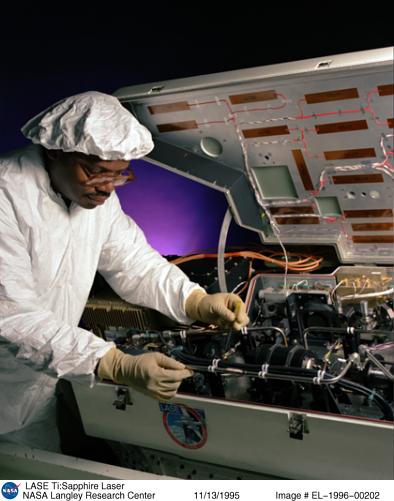
Dr. Larry B. Petway (Science Applications International Corp.) is making final adjustments to the Ti:Sapphire Laser in preparing the Lidar Atmospheric Sensing Experiment (LASE) Instrument for integration into a NASA/ER-2 aircraft. LASE is the first fully- engineered, autonomous differential Absorption Lidar (DIAL) System for the measurement of water vapor, aerosol and cloud in the troposphere.
What is it?
DIAL lidars are used to monitor trace gases and require 2 laser sources of nearly the same wavelength. One laser source emits near the wavelength of peak absorption of the target trace gas, and the other emits in the region where the target gas does not absorb.
The reflected energy falls off as the distance from the reflector increases according to the 1/R2 rule. The beam that is absorbed by the target gas will fall even faster due to the absorption of the gas between the source and the reflector and between the reflector and the detector. The ratio of the power in the returned on-line laser pulse to the power in the off-line laser pulse is related to the absorption of the target gas species.
We already know that the absorption profile as a function of wavelength is unique for each type of molecule. The strength and width of the absorption lines also depend on density, pressure, and temperature of the gas. By carefully choosing our target gas, we can used LIDAR to monitor different things in the atmosphere. For example, if we choose a target gas whose concentration doesn’t vary globally and that is locally well mixed with the other gases, then we can use our LIDAR to infer the atmospheric temperature.
Usually, though, DIAL lidar is used to determine the density (concentration) of a particular atmospheric trace gas as a function of distance from the receiver.